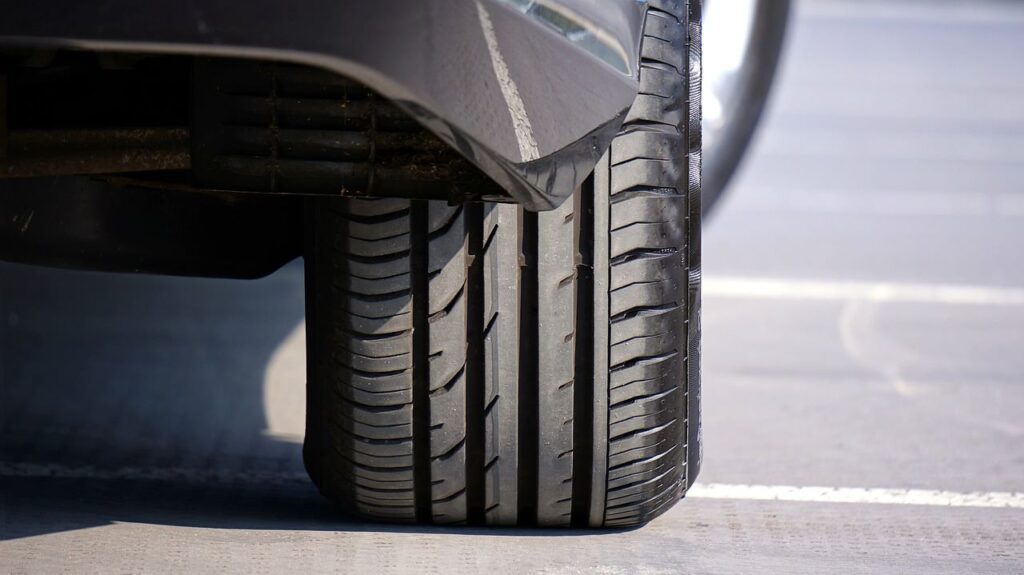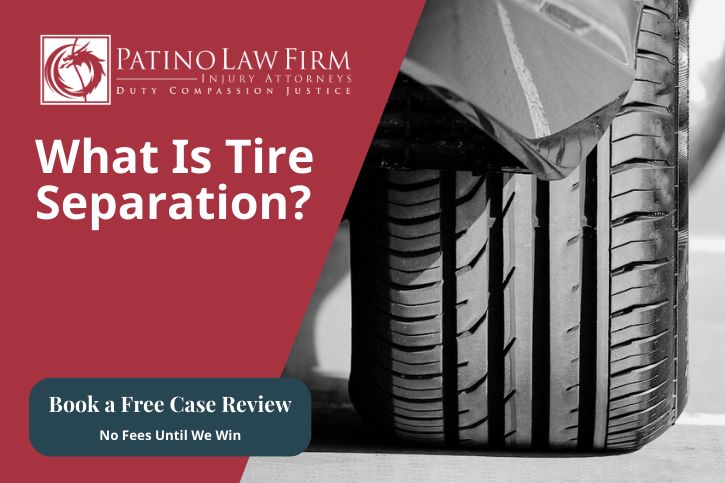Whether you’re on the school run, doing the daily commute to work, or heading out on a weekend drive, you trust your tires to do their job and get you there safely.
But tires wear away over time, or they can be defective and rupture unexpectedly.
One safety issue impacting tires is tire tread separation.
In this blog post, McAllen and San Antonio accident attorney Dr. Louis Patino and his team explain what tire separation is, what causes it, the common signs you should look out for, and your options for compensation if you’re injured in an accident caused by a separated tire.
What Is Tread Separation?
Tire separation is when a tire’s tread separates or splits from its casing. The tread is, quite literally, where the rubber meets the road, the outermost layer of a tire that makes contact with the asphalt and provides grip.
What Causes Tire Tread Separation?
Tire separation can happen for many reasons, but before we explain the factors that can trigger it, let’s look at how it occurs and why it is even a problem.
Tire separation often happens to steel-belted radial tires, which is how the tread or rubber is fused to the tire’s casing. Steel-belted radial tires comprise three primary components:
- A cord body
- Steel belts
- Rubber tread.
The steel belts are fused to the tire body, and the rubber to the steel belt. But in some scenarios — which we’ll dig into shortly — the rubber tread will separate from the steel belt.
However, tire separation can also occur when the steel belts come loose from the cord body.
When tread separation occurs, drivers can lose control of their vehicle and crash into guardrails, other motorists, or pedestrians, causing a potentially deadly crash.
Most vehicles on the road today are fitted with steel-belted radial tires, making this a critical safety issue all motorists should know about.
So, what factors can increase the likelihood of a tire separating? We explore the most common causes of split tires.
Manufacturing Defects
The most common cause of tire separation is a manufacturing defect. Flaws in a tire’s composition can be introduced when the steel belts and tread are not properly bonded during production. For example, contaminants like moisture, dirt, or oils can interfere with the bonding process and lead to weak spots in the tire. Even minor imperfections during manufacturing can compromise the tire’s structural integrity, increasing the risk of the tire splitting under stress.
Improper Tire Repair
Damaged tires must be properly repaired to ensure safety, but repair shops might cut corners — whether you know it or not.
Poor car maintenance can increase the risk of tire separation, especially after a puncture. One such improper method is to insert a plug into the hole left by a blown tire. While this may prove a quick fix, it compromises the tire’s structural integrity and is impractical in the long term.
As the tire is continually exposed to stress — from driving at the maximum speed limit down a highway where there’s little traffic or navigating a speed hump — the plug can move and expand the gap between the tire tread and casing, causing separation.
Underinflation and Overinflation
Maintaining the correct tire pressure is essential for the longevity and safety of your tires. Under-inflated tires can split because the tire’s internal components have degraded. This is a common scenario that happens because the lack of pressure causes the sidewalls to flex and the tire to overheat.
However, maintaining tire pressure requires a delicate balance, and over-inflating a tire can equally make it prone to splitting.
Like underinflation, over-inflating a tire can create excess heat, increasing wear and degradation. Overinflation can also cause tire splitting because it prevents it from effectively absorbing shocks, so even a slight bump can be what finally separates the tread from the belt.
Environmental temperature changes can significantly affect road surface temperature and cause tire pressure changes, and with weather and temperature often fluctuating, it’s a common problem on Texas roads.
Old Tires
We may all be guilty of pushing a tire slightly past its limits — one more trip won’t hurt when you’re due for a service — but tires do not perform well once deterioration sets in, and they certainly don’t last forever. As tires age, they become increasingly vulnerable to the slightest knock, bump, and vibration, and that might be all it takes to split a degraded tire.
Overloading
Overloading a vehicle is another form of stress on your tires. Carrying loads exceeding your vehicle’s or tire’s rated capacity puts additional strain on your tires that they are not designed and tested to handle, increasing the rate of degradation and likelihood of splitting.
Road Hazards
Poor road conditions and hazards like potholes can be all it takes to split an already weakened, degraded, or worn tire, but they can also cause unseen damage to a moderately used tire that will only worsen over time. This situation is dangerous, as a motorist might not realize it until the tire separates and causes a collision.
Recognizing the Signs of Tire Separation
Knowing the signs of tire separation is critical for detecting when there might be an issue. Understanding what to look out for can help avoid a crash caused by a split — and save lives.
Bulges or Blisters
One of the most visible signs of a tire problem is bulges or blisters on the tire’s surface. A tire blister or bulge is often a weak spot in the tire protruding outward, caused by the internal layers of the tire separating.
Cracks or Cuts in the Sidewall
Cracks or cuts in the tire’s sidewall appear when a tire has deteriorated. If not addressed promptly, cuts and cracks can lead to separation. Inspecting your tires for visible damage regularly can help you catch these issues early.
Vibrations while Driving
Experiencing unusual vibrations while driving, particularly at higher speeds, could suggest an imminent — or already present — tire split. As the tread separates, it creates an uneven surface, causing a vibration as it contacts the road.
Any of these signs can suggest a tire has or is likely to separate, but that doesn’t mean a driver will always see warning signs.
Tires can separate despite appearing to be in otherwise serviceable condition. Your tires may still have plenty of rubber, maintain pressure, and provide grip. However, if it is overdue for a replacement, or it is under constant stress by being subjected to heavy loads, it could separate at any time. Even newer tires can split if a manufacturing defect is the cause.
These possibilities make it vital to regularly get your vehicle serviced, inspect your tires for holes, pressure changes, cuts, and abnormalities in the vehicle’s sound or handling while driving, and head immediately to a trusted repair shop if you have any concerns about your tire integrity — not put it off for another day.
Related Reading: Where to Get Your Car Repaired
Getting Compensation after a Texas Tire Separation Accident
If you or a loved one has been injured in an accident caused by tire separation, you may be entitled to compensation for your losses. In Texas, personal injury law allows victims of accidents caused by defective products, such as tires, to file claims against the manufacturer, retailer, or other responsible parties, such as a repair shop.
To succeed in a tire separation claim, you’ll need to gather evidence to prove that the tire was defective or that someone else’s negligence majorly contributed to causing your accident. Our San Antonio and McAllen-based personal injury lawyer can help you navigate the complex legal process and explain your rights. Acting quickly to preserve evidence and seek legal counsel can make a significant difference in the outcome of your case.
Call 855-LAW-NINJA or submit a confidential contact form today to book a free, no-obligation case review with one of Texas’s best personal injury attorneys. Our dedicated team has decades of combined experience pursuing car accident and product liability claims, and we have secured six and seven-figure settlements and court judgments for our clients.
We will fight to maximize your compensation payout and never encourage you to settle for less than you deserve. You don’t pay fees until we win.



